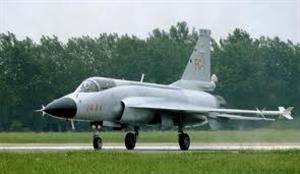Chengdu FC-1
After the western powers pulled out of the Super 7 project in early 1990 in the wake of the Tiananmen Square massacre and the project was cancelled, China decided to carry on with the light fighter programme alone. In 1991 the Chengdu Aircraft Co. launched a new project designated Chengdu FC-1 (FC-1 – Fighter China-1) and bearing the name Xiaolong (Fierce Dragon) – primarily for the export market. The Russian ‘fighter maker’ RSK MiG was actively involved in the design process. Pakistan, the launch customer, was also a risk-sharing partner, accepting 50% of the development costs which amounted to some US$ 150 million; the Pakistani designation was JF-17 Thunder (JF stood for Joint Fighter).
The aircraft had virtually nothing in common with the Super-7 whose origins lay in the J-7 family. The Chengdu FC-1 had a blended wing/body design with mid-set trapezoidal wings swept back 42° at quarter-chord, with small scimitar- shaped LERXes and leading-edge manoeuvring flaps. The tail surfaces were also trapezoidal, with raked tips and no trailing-edge sweep; the stabilators were mounted on blended horizontal booms which also carried small ventral fins on the outer edges. The fuselage nose incorporated an ogival radome; the cockpit had a one-piece windscreen and an aft-hinged canopy. The nose gear unit retracted aft and the main ones forward.
The Chengdu FC-1 was built around a Klimov RD-93 afterburning turbofan (a derivative of the MiG-29’s RD-33 engine) rated at 5,040 kgp (11,100 lbst) dry and 8,300 kgp (18,300 lbst) in full afterburner. The engine breathed through two semi-circular air intakes with boundary layer splitter plates.
The aircraft had conventional mechanical powered flight controls, although FBW controls were considered for future versions. In keeping with current trends the FC-1 had a ‘glass cockpit’ with a wide-angle HUD and two MFDs, plus HOTAS controls. The FC-1’s avionics architecture was supported by two mission computers linked by a MIL-STD-1553B databus.
The choice of radar depended on the customer; thus, Israeli Elta ELyM-2032, the British GEC-Marconi Blue Diamond, the French Thomson-CSF RDY or Thales RC400, the Russian Phazotron-NIIR Kop’yo (Spear) or the Italian Galileo (ex-FIAR) Grifo S7 could be fitted to export aircraft, while the domestic version would have the KLJ-10 radar.
 Seven external stores points were provided, including wingtip missile launch rails; the centreline pylon and the innermost wing pylons were ‘wet’, permitting carriage of drop tanks.
Seven external stores points were provided, including wingtip missile launch rails; the centreline pylon and the innermost wing pylons were ‘wet’, permitting carriage of drop tanks.
The Pakistan Air Force planned eventual installation of an IFR probe. Possible air-to-air weapons included the PL-9, AIM-9P, Matra Magic 2 short-range AAMs and PL-11, PL-12 (SD-10) and R-27ER1 medium-range AAMs. A 23-mm Type 23-2 twin-barrel cannon was fitted on the port side of the lower centre fuselage. Various guided and unguided air-to-sur- face weapons could be carried, with provisions for a laser designator pod for delivering laser- guided weapons.
